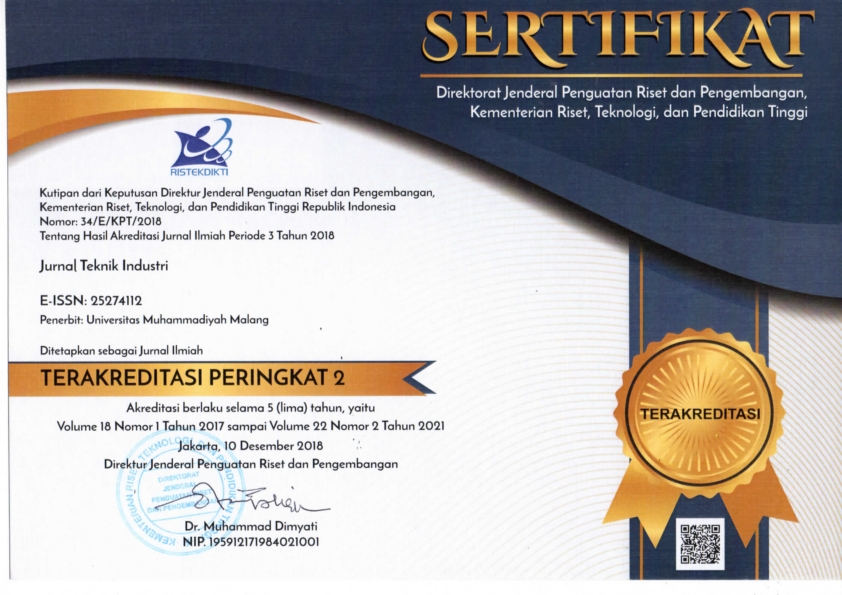Selection for Technology Acquisition using AHP: A Case Study of Tulip VAWT Effectiveness
DOI:
https://doi.org/10.22219/JTIUMM.Vol25.No1.1-12Keywords:
Technology acquisition, Innovation, Wind energy, Small-size VAWT, AHPAbstract
The increasing energy demand in Indonesia, particularly from the industrial sector, has heightened the need to reduce reliance on fossil fuels by integrating new and renewable energy (NRE) sources into the energy mix. For the industrial sector, adopting NRE technologies presents options such as purchasing, manufacturing, or acquiring technology. This study focuses on selecting the most effective option for a small Vertical Axis Wind Turbine (VAWT), specifically the Tulip VAWT, by evaluating its hardware performance. The selection process utilizes subjective judgment and the Analytical Hierarchy Process (AHP), considering five key factors: installability, usability, affordability, availability, and maintainability. Results indicate that Technology Acquisition (TA) is the optimal choice, with an AHP score of 0.65, outperforming the purchasing options (0.322) and manufacturing options (0.296). These findings suggest that evaluating these five factors significantly impacts the decision-making process regarding adopting the Tulip VAWT. However, the study does not assess the effectiveness of the associated knowledge (software) or organizational factors, as no established methodology exists for this evaluation yet.
Downloads
References
M. F. Ibrahim and M. M. Putri, "Integrated Green Supply Chain Model to Reduce Carbon Emission with Permissible Delay-in-Payment Consideration," Jurnal Teknik Industri, vol. 20, no. 2, pp. 128-139, 2019. https://doi.org/10.22219/JTIUMM.Vol20.No2.128-139.
I. Kurniawan, R. Ichwani, R. Fionasari, A. Batubara, and A. Huda, "Indonesia's Renewable Energy Outlook: What to Expect in The Future Renewable Energy of Indonesia. A Brief Review," Elkawnie: Journal of Islamic Science and Technology, vol. 8, no. 2, pp. 298-313, 2022. http://dx.doi.org/10.22373/ekw.v8i2.18738.
N. A. Pambudi et al., "Renewable energy in Indonesia: current status, potential, and future development," Sustainability, vol. 15, no. 3, p. 2342, 2023. https://doi.org/10.3390/su15032342.
M. Shapsugova, "ESG principles and social responsibility," 2023, vol. 420, p. 06040: EDP Sciences. https://doi.org/10.1051/e3sconf/202342006040.
A. H. Zakaria, F. Firdaus, K. F. Arifin, M. S. Munawar, and A. Gunawan, "Pengaruh Penerapan Kebijakan Tkdn (Tingkat Komponen Dalam Negeri) Terhadap Daya Saing Produk Keramik," Jurnal Ekobis Dewantara, vol. 6, no. 1, 2023.
W.-T. Chong et al., "Cross axis wind turbine: Pushing the limit of wind turbine technology with complementary design," Applied Energy, vol. 207, pp. 78-95, 2017. https://doi.org/10.1016/j.apenergy.2017.06.099.
M. A. Al-Rawajfeh and M. R. Gomaa, "Comparison between horizontal and vertical axis wind turbine," International Journal of Applied, vol. 12, no. 1, pp. 13-23, 2023. http://doi.org/10.11591/ijape.v12.i1.pp13-23.
F. Castellani, D. Astolfi, M. Peppoloni, F. Natili, D. Buttà, and A. Hirschl, "Experimental vibration analysis of a small scale vertical wind energy system for residential use," Machines, vol. 7, no. 2, p. 35, 2019. https://doi.org/10.3390/machines7020035.
M. Zilberman, A. Abu Sbaih, and I. Hadad, "Optimized Small Vertical Axis Wind Turbine (VAWT), Phase I," 2021, vol. 85536, p. V001T09A001: American Society of Mechanical Engineers. https://doi.org/10.1115/GTINDIA2021-74879.
P. Prakash, C. Sucheth, S. Mitra, and N. Mishra, "A Feasibility Analysis of Using Savonius VAWT on a Vehicle for Energy Capture," 2022, pp. 185-200: Springer. https://doi.org/10.1007/978-981-99-7047-6_14.
J. Radhakrishnan, S. Sridhar, M. Zuber, E. Y. K. Ng, and S. Shenoy, "Design optimization of a Contra-Rotating VAWT: A comprehensive study using Taguchi method and CFD," Energy Conversion and Management, vol. 298, p. 117766, 2023. https://doi.org/10.1016/j.enconman.2023.117766.
I. Shchur, V. Klymko, S. Xie, and D. Schmidt, "Design features and numerical investigation of counter-rotating VAWT with co-axial rotors displaced from each other along the axis of rotation," Energies, vol. 16, no. 11, p. 4493, 2023. https://doi.org/10.3390/en16114493.
R. W. Saaty, "The analytic hierarchy process—what it is and how it is used," Mathematical modelling, vol. 9, no. 3-5, pp. 161-176, 1987. https://doi.org/10.1016/0270-0255(87)90473-8.
R. Smith and N. Sharif, "Understanding and acquiring technology assets for global competition," Technovation, vol. 27, no. 11, pp. 643-649, 2007. https://doi.org/10.1016/j.technovation.2007.04.001.
K. W. Platts, "A process approach to researching manufacturing strategy," International Journal of Operations & Production Management, vol. 13, no. 8, pp. 4-17, 1993. https://doi.org/10.1108/01443579310039533.
T. Baines, "An integrated process for forming manufacturing technology acquisition decisions," International Journal of Operations & Production Management, vol. 24, no. 5, pp. 447-467, 2004. https://doi.org/10.1108/01443570410532533.
H. Murnawan and P. E. D. K. Wati, "Perancangan ulang fasilitas dan ruang produksi untuk meningkatkan output produksi," Jurnal Teknik Industri, vol. 19, no. 2, pp. 157-165, 2018. https://doi.org/10.22219/JTIUMM.Vol19.No2.157-165.
M. Y. Asdidi, M. Alpianto, and A. A. Yaqin, "Evaluasi Supplier Dengan Menggunakan Metode Analytical Hierarchy Process Dan Taguchi Loss Function," Jurnal Teknik Industri, vol. 19, no. 2, pp. 178-189, 2018. https://doi.org/10.22219/JTIUMM.Vol19.No2.178-189.
H. Sari and D. A. Nurhadi, "Designing marketing strategy based on value from clothing-producing companies using the AHP and Delphi methods," Jurnal Teknik Industri, vol. 20, no. 2, pp. 191-203, 2019. https://doi.org/10.22219/JTIUMM.Vol20.No2.191-203.
S. I. Satoglu and I. Türkekul, "Selection of Material Handling Equipment using the AHP and MOORA," Jurnal Teknik Industri, vol. 22, no. 1, pp. 113-124, 2021. https://doi.org/10.22219/JTIUMM.Vol22.No1.113-124.
R. Velmurugan, S. Selvamuthukumar, and R. Manavalan, "Multi criteria decision making to select the suitable method for the preparation of nanoparticles using an analytical hierarchy process," Die Pharmazie-An International Journal of Pharmaceutical Sciences, vol. 66, no. 11, pp. 836-842, 2011. https://doi.org/10.1691/ph.2011.1034.
D. Wardianto, M. Mafrizal, S. Sufiyanto, R. K. Arief, H. A. Prabowo, and I. Hilmy, "The model selection of propeller turbine construction using Analytical Hierarchy Process (AHP)," SINERGI, vol. 27, no. 8, pp. 361-370, 2023. https://dx.doi.org/10.22441/sinergi.2023.3.007.
D. Hendriana, M. H. Aziz, G. A. Subekti, U. Said, G. Baskoro, and H. Nasution, "Wind Speed Measurements and Comparisons in Cakung Jakarta," 2022, pp. 1-6. https://doi.org/10.1145/3557738.3557884.
G. Baskoro, I. Mariza, and I. N. Sutapa, "Innovation to Improve Critical Thinking Skills in the Generation Z using Peeragogy as a Learning Approach and Artificial Intelligence (AI) as a Tool," Jurnal Teknik Industri: Jurnal Keilmuan dan Aplikasi Teknik Industri, vol. 25, no. 2, pp. 121-130, 2023. https://doi.org/10.9744/jti.25.2.121-130.
Downloads
Published
How to Cite
Issue
Section
License
Copyright (c) 2024 Gembong Baskoro, Edhie Sarwono, Galih Akup Subekti, Dena Hendriana, Henry Nasution

This work is licensed under a Creative Commons Attribution-ShareAlike 4.0 International License.











